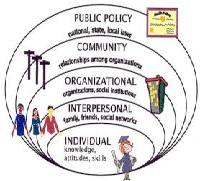Social Ecological Model use by Health Personnel Order Instructions: kindly view the attached file.
Social Ecological Model use by Health Personnel Sample Answer
SOCIAL-ECOLOGICAL MODEL
Social Ecological Model (SEM) is the classifying structure which health personnel can utilize to better comprehend the whole connection among societal factors, community factors, relationship factors, and individual factors.

Prevention is the general objective of eliminating or avoiding unconstructive health problems. On the contrary to this, the Special Forces are mandatory to be evaluated so as to establish active involvements. Even though various descriptions of the social, ecological model have been established for personal health challenges, they have in general the idea of multilevel arrangements of joint pressure and relationship, migrating from the person stage throughout connections to larger social networks which entail the government, social organizations, environment, community, and family.
Health is strong-minded by the manipulation at different stages that are intrapersonal factors, interpersonal factors, institutional factors, community factors, and public policy factors. The model offers an all-around analysis of the relations among productivity, learning, and health. The concept recognizes environmental forces and pressures that connect and involve personal behavior. The forces might be the place or physical setting, attributes of the people, surrounding community and organizations.
Since important and active interconnections exist between the various stages of the health determinant, involvements are more likely to be efficient when they talk about determinant at all stages. In the social, ecological model, the health state and behavior are as a result of interest and are resolute by the following:
Social Ecological Model use by Health Personnel and Intrapersonal factors
Most of the behavior shifts or change models that are commonly used in public health and health promotion are generated from psychology. When the psychological ideologies are implemented to specific health issues, the outcome model might include physiological procedures or the interpersonal pressures. The involvement at the interpersonal stage utilize different stages of involvement to help change the behavior of an individual, and the attributes of the persons include skills, attitudes, knowledge and the intent to abide by the behavioral norms, (DiClemente, Salazar, & Crosby, 2013).
Interpersonal connections with friends, workmates, neighbors and family members are the significant source of persuasions in the health linked behaviors of persons. Even though the manipulation of the interpersonal linkage on the health linked behaviors of persons is broadly known, health promotion involvement which utilizes interpersonal plans has naturally concentrated on changing people during the social persuasions rather than changing the social teams or norms that people fit in the right place.
Social Ecological Model use by Health Personnel and Community factor
The idea of a community is a major fundamental concept in sociology, and it always occupies the federal position in the sector of public health. The community is a political center or a meeting place that acts as a unit of attractive social relationships or as the aggregate of people in a given geographical place, (Golden, McLeroy, Green, Earp, & Lieberman, 2015). The community has three different ways that help define the differing conclusion for the implementations and development of public health and health promotion practice. First, is a mediating framework where individuals meet face to face. Secondly, the connection among companies and teams in a defined place. Lastly, it is the graphical and political terms.
Social Ecological Model use by Health Personnel and the Public policy factors
The use of public policy has helped maintain the attributes of public health. The utilization of this element has a dramatic impact on the health of the people. The factor has helped in minimization of disability and death from chronic infectious diseases by addressing those using rules that strictly confine behaviors like smoking in public places and constraint of alcohol consumption and sale.
Social Ecological Model use by Health Personnel Conclusion
The social, ecological model stands for a complete advancement to formulating, applying and assess involvements that focus on the various factors on behavior entailing physical activity behavior.
Social Ecological Model use by Health Personnel References
DiClemente, R. J., Salazar, L. F., & Crosby, R. A. (2013). Health behavior theory for public health. Jones & Bartlett Publishers.
Golden, S. D., McLeroy, K. R., Green, L. W., Earp, J. A. L., & Lieberman, L. D. (2015). Upending the social-ecological model to guide health promotion efforts toward policy and environmental change.
http://tamhsc.academia.edu/KennethMcLeroy/Papers/81901/An_Ecological_Perspective_on_Health_Promotion_Programs




